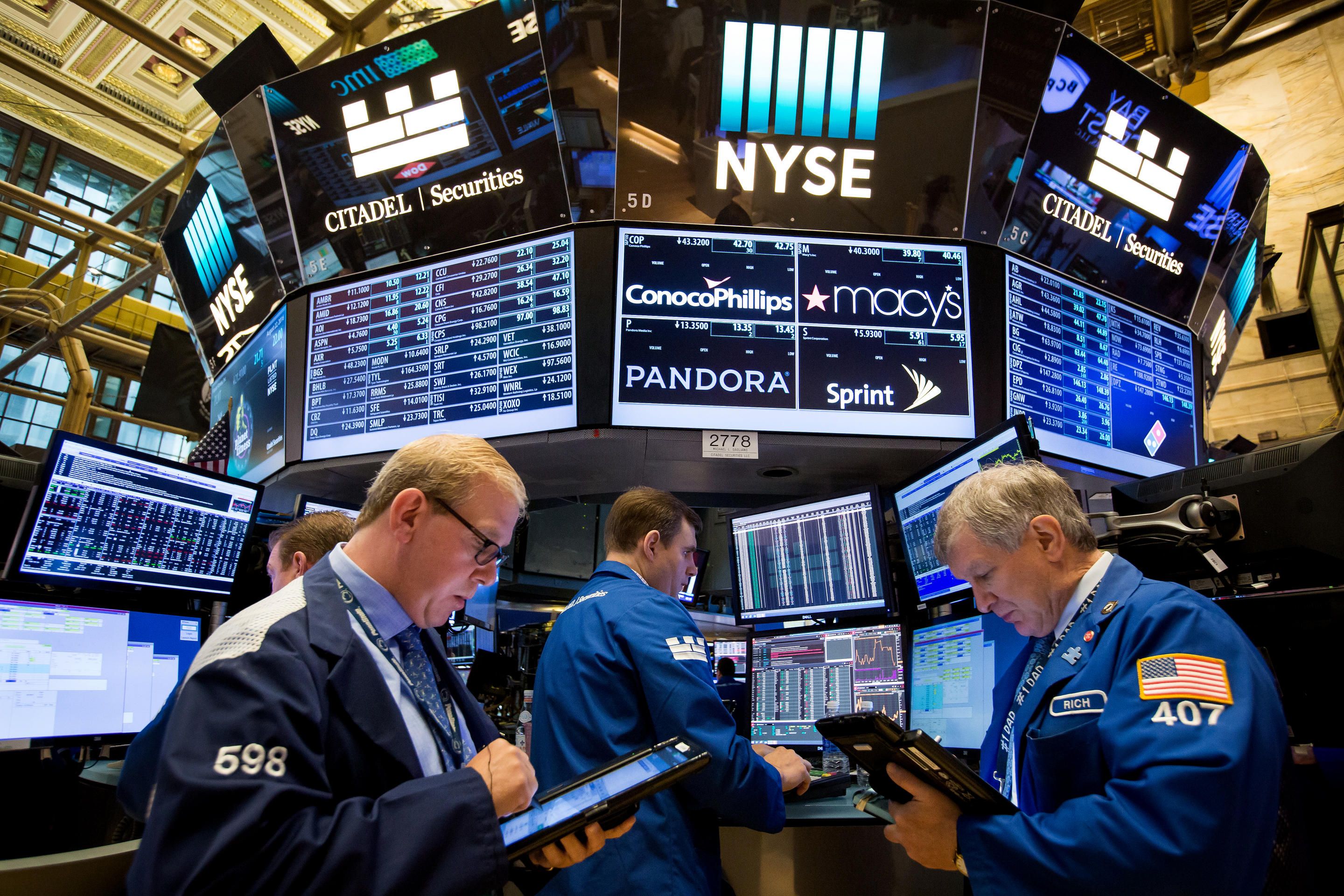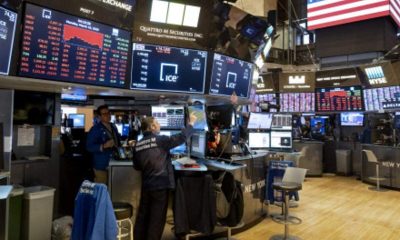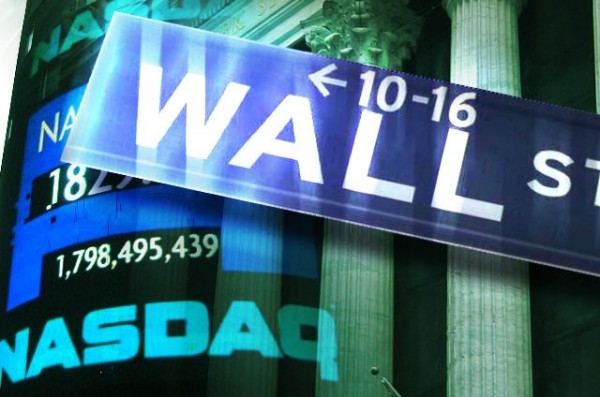Economy
US Stocks Open Higher on Easing Trade Concerns

By Investors Hub
The major U.S. index futures are pointing to a higher opening on Thursday, with stocks likely to move back to the upside following the pullback seen in the previous session.
The upward momentum on Wall Street comes amid easing trade war concerns after news of U.S. threats of a new 10 percent tariff on $200 billion worth of Chinese imports contributed to the weakness on Wednesday.
China vowed to take countermeasures in response to the new tariffs, although the markets may respond positively to the lack of the announcement of specific retaliation by the Chinese.
Traders also seem optimistic the continued tariff threats will eventually bring the U.S. and China to the table for talks that could result in a long-term trade agreement.
After trending higher over the past several sessions, stocks gave back some ground during trading on Wednesday amid renewed trade concerns. With the drop on the day, the S&P 500 pulled back off its best closing level in five months.
The major averages ended the session firmly in negative territory but off their worst levels of the day. The Dow slumped 219.21 points or 0.9 percent to 24,700.45, the Nasdaq fell 42.59 points or 0.6 percent to 7,716.61 and the S&P 500 slid 19.82 points or 0.7 percent to 2,774.02.
The weakness on Wall Street came amid renewed concerns about the economic impact of a global trade war after President Donald Trump’s administration proposed new tariffs on China.
Trump has ordered U.S. Trade Representative Robert Lighthizer to begin the process of imposing tariffs of 10 percent on an additional $200 billion of Chinese imports.
The move comes after the U.S. imposed a 25 percent tariff on $34 billion worth of Chinese imports last Friday, leading China to retaliate by imposing tariffs on $34 billion worth of U.S. exports.
“For over a year, the Trump Administration has patiently urged China to stop its unfair practices, open its market, and engage in true market competition,” Lighthizer said. “We have been very clear and detailed regarding the specific changes China should undertake.”
“Unfortunately, China has not changed its behavior – behavior that puts the future of the U.S. economy at risk,” he added. “Rather than address our legitimate concerns, China has begun to retaliate against U.S. products. There is no justification for such action.”
In U.S. economic news, the Labor Department released a report showing producer prices increased by slightly more than expected in the month of June.
The Labor Department said its producer price index for final demand rose by 0.3 percent in June after climbing by 0.5 percent in May. Economists had expected prices to edge up by 0.2 percent.
Excluding food and energy prices, core producer prices also climbed by 0.3 percent in June, matching the increase seen in May. Core prices had been expected to rise by 0.2 percent.
Compared to the same month a year ago, producer prices were up by 3.4 percent in June, representing the largest 12-month increase since a 3.7 percent jump in November of 2011.
Gold stocks moved sharply lower over the course of the session, dragging the NYSE Arca Gold Bugs Index down by 2.9 percent. The weakness among gold stocks came amid a notable decrease by the price of the precious metal.
Substantial weakness was also visible among steel stocks, as reflected by the 2.8 percent drop by the NYSE Arca Steel Index. The index pulled back after closing higher for four straight sessions.
Energy stocks also came under pressure on the day amid a steep drop by the price of crude oil. Semiconductor, telecom and computer hardware stocks also saw considerable weakness, moving lower along with most of the other major sectors.
Economy
Customs Street Chalks up 0.12% on Santa Claus Rally

By Dipo Olowookere
The Nigerian Exchange (NGX) Limited witnessed Santa Claus rally on Wednesday after it closed higher by 0.12 per cent.
Strong demand for Nigerian stocks lifted the All-Share Index (ASI) by 185.70 points during the pre-Christmas trading session to 153,539.83 points from 153,354.13 points.
In the same vein, the market capitalisation expanded at midweek by N118 billion to N97.890 trillion from the preceding day’s N97.772 trillion.
Investor sentiment on Customs Street remained bullish after closing with 36 appreciating equities and 22 depreciating equities, indicating a positive market breadth index.
Guinness Nigeria chalked up 9.98 per cent to trade at N318.60, Austin Laz improved by 9.97 per cent to N3.20, International Breweries expanded by 9.85 per cent to N14.50, Transcorp Hotels rose by 9.83 per cent to N170.90, and Aluminium Extrusion grew by 9.73 per cent to N16.35.
On the flip side, Legend Internet lost 9.26 per cent to close at N4.90, AXA Mansard shrank by 7.14 per cent to N13.00, Jaiz Bank declined by 5.45 per cent to N4.51, MTN Nigeria weakened by 5.21 per cent to N504.00, and NEM Insurance crashed by 4.74 per cent to N24.10.
Yesterday, a total of 1.8 billion shares valued at N30.1 billion exchanged hands in 19,372 deals versus the 677.4 billion shares worth N20.8 billion traded in 27,589 deals in the previous session, implying a slump in the number of deals by 29.78 per cent, and a surge in the trading volume and value by 165.72 per cent and 44.71 per cent apiece.
Abbey Mortgage Bank was the most active equity for the day after it sold 1.1 billion units worth N7.1 billion, Sterling Holdings traded 127.1 million units valued at N895.9 million, Custodian Investment exchanged 115.0 million units for N4.5 billion, First Holdco transacted 40.9 million units valued at N2.2 billion, and Access Holdings traded 38.2 million units worth N783.3 million.
Economy
Yuletide: Rite Foods Reiterates Commitment to Quality, Innovation

By Adedapo Adesanya
Nigerian food and beverage company, Rite Foods Limited, has extended warm Yuletide greetings to Nigerians as families and communities worldwide come together to celebrate the Christmas season and usher in a new year filled with hope and renewed possibilities.
In a statement, Rite Foods encouraged consumers to savour these special occasions with its wide range of quality brands, including the 13 variants of Bigi Carbonated Soft Drinks, premium Bigi Table Water, Sosa Fruit Drink in its refreshing flavours, the Fearless Energy Drink, and its tasty sausage rolls — all produced in a world-class facility with modern technology and global best practices.
Speaking on the season, the Managing Director of Rite Foods Limited, Mr Seleem Adegunwa, said the company remains deeply committed to enriching the lives of consumers beyond refreshment. According to him, the Yuletide period underscores the values of generosity, unity, and gratitude, which resonate strongly with the company’s philosophy.
“Christmas is a season that reminds us of the importance of giving, togetherness, and gratitude. At Rite Foods, we are thankful for the continued trust of Nigerians in our brands. This season strengthens our resolve to consistently deliver quality products that bring joy to everyday moments while contributing positively to society,” Mr Adegunwa stated.
He noted that the company’s steady progress in brand acceptance, operational excellence, and responsible business practices reflects a culture of continuous improvement, innovation, and responsiveness to consumer needs. These efforts, he said, have further strengthened Rite Foods’ position as a proudly Nigerian brand with growing relevance and impact across the country.
Mr Adegunwa reaffirmed that Rite Foods will continue to invest in research and development, efficient production processes, and initiatives that support communities, while maintaining quality standards across its product portfolio.
“As the year comes to a close, Rite Foods Limited wishes Nigerians a joyful Christmas celebration and a prosperous New Year filled with peace, progress, and shared success.”
Economy
Naira Appreciates to N1,443/$1 at Official FX Market

By Adedapo Adesanya
The Naira closed the pre-Christmas trading day positive after it gained N6.61 or 0.46 per cent against the US Dollar in the Nigerian Autonomous Foreign Exchange Market (NAFEM) on Wednesday, December 24, trading at N1,443.38/$1 compared with the previous day’s N1,449.99/$1.
Equally, the Naira appreciated against the Pound Sterling in the same market segment by N1.30 to close at N1,949.57/£1 versus Tuesday’s closing price of N1,956.03/£1 and gained N2.94 on the Euro to finish at N1,701.31/€1 compared with the preceding day’s N1,707.65/€1.
At the parallel market, the local currency maintained stability against the greenback yesterday at N1,485/$1 and also traded flat at the GTBank forex counter at N1,465/$1.
Further support came as the Central Bank of Nigeria (CBN) funded international payments with additional $150 million sales to banks and authorised dealers at the official window.
This helped eased pressure on the local currency, reflecting a steep increase in imports. Market participants saw a sequence of exchange rate swings amidst limited FX inflows.
Last week, the apex bank led the pack in terms of FX supply into the market as total inflows fell by about 50 per cent week on week from $1.46 billion in the previous week.
Foreign portfolio investors’ inflows ranked behind exporters and the CBN supply, but there was support from non-bank corporate Dollar volume.
As for the cryptocurrency market, it witnessed a slight recovery as tokens struggled to attract either risk-on enthusiasm or defensive flows.
The inertia follows a sharp reversal earlier in the quarter. A heavy selloff in October pulled Bitcoin and other coins down from record levels, leaving BTC roughly down by 30 per cent since that period and on track for its weakest quarterly performance since the second quarter of 2022. But on Wednesday, its value went up by 0.9 per cent to $87,727.35.
Further, Ripple (XRP) appreciated by 1.7 per cent to $1.87, Cardano (ADA) expanded by 1.2 per cent to $0.3602, Dogecoin (DOGE) grew by 1.1 per cent to $0.1282, Litecoin (LTC) also increased by 1.1 per cent to $76.57, Solana (SOL) soared by 1.0 per cent to $122.31, Binance Coin (BNB) rose by 0.6 per cent to $842.37, and Ethereum (ETH) added 0.3 per cent to finish at $2,938.83, while the US Dollar Tether (USDT) and the US Dollar Coin (USDC) remained unchanged at $1.00 each.
-

 Feature/OPED6 years ago
Feature/OPED6 years agoDavos was Different this year
-
Travel/Tourism9 years ago
Lagos Seals Western Lodge Hotel In Ikorodu
-

 Showbiz3 years ago
Showbiz3 years agoEstranged Lover Releases Videos of Empress Njamah Bathing
-

 Banking8 years ago
Banking8 years agoSort Codes of GTBank Branches in Nigeria
-

 Economy3 years ago
Economy3 years agoSubsidy Removal: CNG at N130 Per Litre Cheaper Than Petrol—IPMAN
-

 Banking3 years ago
Banking3 years agoFirst Bank Announces Planned Downtime
-

 Banking3 years ago
Banking3 years agoSort Codes of UBA Branches in Nigeria
-

 Sports3 years ago
Sports3 years agoHighest Paid Nigerian Footballer – How Much Do Nigerian Footballers Earn
















